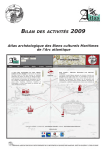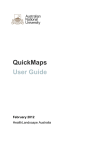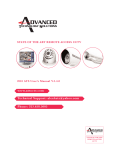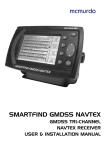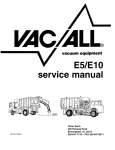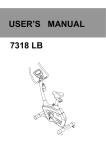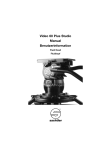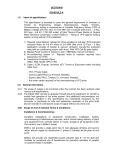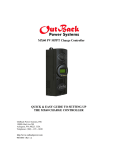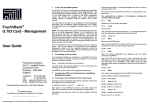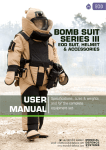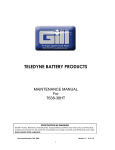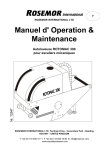Download 005/002/029.001 - Royal Berkshire Fire and Rescue Service
Transcript
005/002/029.001 Nov 2011 WATER RESCUES & WATER RELATED INCIDENTS (Version 1.00) (Protective Marking NONE) Part A: Aide Memoir HAZARDS Assessing the incident Intimidation / violence from members of the public / affected person. Rescues carried out near water Slips trips and fall injuries when traversing around incident site. Falls into water. Entrapment by immersion or submersion of personnel by unstable surface (mud, silt, ice, etc). Biohazards from contact with soiled or contaminated substances. Manual handling. Wade rescues All bank side hazards before entering water. Falls in water due to obscured changes in water levels. Entrapment by visible and obscured objects. Struck by water borne debris/ surface water vessel movement. Biohazards from contact with soiled or contaminated substances. Exposure to extremes of temperature. Harm to rescuer from non compliant casualty. Rapid uncontrolled rises in water levels and flow rates. Inappropriate use of equipment. Rescues from Water All bank side hazards before launching craft into water. Manual handling when manoeuvring craft/casualty. Biohazards from contact with soiled or contaminated substances. Craft struck by obscured and hidden obstructions, water surface vessel movements and water borne debris. Rapid uncontrolled rises in water levels and flow rates and catastrophic damage to the national infrastructure. Harm to rescuer from non compliant casualty. Swim rescues All bank side hazards before entering water. Entrapment by visible and obscured objects. Struck by water borne debris/ surface water vessel movement. Rapid uncontrolled rises in water levels and flow rates. Biohazards from contact with soiled or contaminated substances. Exposure to extremes of temperature. Harm to rescuer from non compliant casualty. Inappropriate use of equipment. Page 1 of 26 Printed: 04/10/2013 005/002/029.001 Nov 2011 Rescues carried out on water All bank side hazards before launching craft into water. Manual handling when manoeuvring craft/casualty. Biohazards from contact with soiled or contaminated substances. Craft struck by obscured and hidden obstructions, water surface vessel movements and water borne debris. Rapid uncontrolled rises in water levels and flow rates and catastrophic damage to the national infrastructure. Harm to rescuer from non compliant casualty. ACTION ON ARRIVAL Conduct DRA prior to committing crews to identify incident type. Establish a 3 metre safety cordon from risk area Ensure appropriate PPE for the rescue intervention level. The following rescue protocols to be adopted according to qualifications of persons present. Rescues Wade Swim Rescues on Task near water Rescues Rescues Water Min CFOA Module 1 Module 2 Module 3 Module 4 Qualification X X X X X X X X Talk Reach Throw Wade Swim Row Craft Power Craft Rescue protocols only to be instigated when appropriate equipment and PPE is present. Liaise with other agency representatives if in attendance. Request attendance of Ambulance Service. Consider early request for helicopter due to flying time to incident. Minimum personnel committed with full safety briefing. On no account should breathing apparatus be used as a control measure for firefighters during water rescues. Page 2 of 26 Printed: 04/10/2013 005/002/029.001 Nov 2011 FURTHER CONSIDERATIONS All personnel in contact with water to be suitably decontaminated. The nature of the casualty may dictate that further resources are required as part of the rescue. When removing a casualty from water the pressure of water that was on the limbs (hydrostatic squeeze) will be lost. If the casualty is in a severe hypothermic state this loss in pressure could result in warm blood suddenly flowing to the limbs, replacing the cold blood which would flow back to the heart. This in turn could lead to heart failure. Therefore, the casualty should be kept as horizontal as possible. All personnel need to be aware that spate conditions may cause catastrophic damage to the national infrastructure (e.g. failure of bridges or loss of roads) which could hamper rescue activities. Personnel should consider whether the incident needs to be treated as a crime scene, and preserve evidence accordingly. Ensure duty of care for incident is left with the relevant authority prior to leaving the scene. Community safety publicity information. Page 3 of 26 Printed: 04/10/2013 005/002/029.001 Nov 2011 Part B: Standard Operating Procedure Introduction This SOP contains rescue intervention protocols regarding rescues from or adjacent to water static or flowing. It aligns to the relevant competence standards which are: CFOA Module 1 Water Awareness (near water). CFOA Module 2 Water First Responder (Wade) in water remaining in contact with ground in an upright position. CFOA Module 3 Water Rescue Technician (Swim) in water not in contact with the ground. CFOA Module 4 Water Rescue Power Boat Operator. Using a craft as platform to carry out rescues from and carry victims to a point of safety. CFOA Module 5 Water Incident Management. Significant Hazards Rescues carried out near water Slips trips and falls injuries when accessing bank side. Due to working on varying terrain, musculoskeletal injuries may occur while moving equipment. Unplanned or accidental immersion or submersion of personnel in water while traversing bank side into water. Entrapment by immersion or submersion of personnel by unstable surface (mud, silt, ice, etc) when moving around incident site Contamination to personnel and equipment due to sewerage, industrial pollutants and other substances that may be present within the risk area: Possible risk of infection and diseases. Hepatitis, Weils disease etc. Rescues carried out in water (Wade, when upright and remaining in contact with the ground.) Falls in water due to obscured changes in water levels / flow and ground conditions. Entrapment by visible and obscured objects. Struck by water borne debris/ surface water vessel movement. Exposure to extremes of temperature. Rapid uncontrolled rises in water levels and flow rates and catastrophic damage to the national infrastructure (e.g. failure of bridges or loss of roads) which could hamper rescue activities. Contamination to personnel and equipment due to sewerage, industrial pollutants and other substances that may be present within the risk area. Possible risk of infection and diseases. Hepatitis, etc. Potential to harm rescuer whilst attempting to rescue non compliant casualty. Inappropriate use of equipment. Page 4 of 26 Printed: 04/10/2013 005/002/029.001 Nov 2011 Swim rescues Falls in water due to obscured changes in water levels/flow and ground conditions. Entrapment by visible and obscured objects. Struck by water borne debris/ surface water vessel movement. Contamination to personnel and equipment due to sewerage, industrial pollutants and other substances that may be present within the risk area. Possible risk of infection and diseases. Hepatitis, etc. Exposure to extremes of temperature. Rapid uncontrolled rises in water levels and flow rates and catastrophic damage to the national infrastructure (e.g. failure of bridges or loss of roads) which could hamper rescue activities. Potential to harm rescuer whilst attempting to rescue non compliant casualty. Inappropriate use of equipment. Rescues carried out on water Manual handling hazard when manoeuvring craft. Falls into water due to craft being struck by obscured and hidden obstructions, water surface vessel movements and water borne debris. Manual handling hazard whilst rescuing victim from water to craft. Contamination to personnel and equipment due to sewerage, industrial pollutants and other substances that may be present within the risk area. Possible risk of infection and diseases. Hepatitis, etc. Rapid uncontrolled rises in water levels and flow rates and catastrophic damage to the national infrastructure (eg failure of bridges or loss of roads) which could hamper rescue activities. Potential to harm rescuer whilst attempting to rescue non compliant casualty. Control Measures and Actions Rescues carried out near water Prior to arrival of more specialist resources, for crews not trained beyond CFOA Module 1, the following rescue protocols to be followed: Talk Reach Throw No personnel to be deployed until the Incident Commander has completed a full dynamic risk assessment, to determine the appropriate safe system of work. Due to working on varying terrain, musculoskeletal injuries may occur while moving equipment. Care should be taken to ensure any moving/lifting is carried out safely. A safety cordon of a minimum of 3 metres from the risk area should be instigated (terrain may increase distance from risk area to beyond 3 metres). All personnel within this cordon as a minimum must wear the following PPE: Life Jacket/ Personal Floatation Device and safety footwear. Page 5 of 26 Printed: 04/10/2013 005/002/029.001 Nov 2011 Brief and deploy 2 upstream spotters and 2 down stream safety with a minimum of two throw lines. to monitor water for vessel movements, water borne debris, and for rescue of personnel. Consider appropriate use of work restraint equipment. Decontamination of rescuers and equipment needs to be conducted following contact with water or mud. Consider community safety impact and releasing safety awareness message. Wade Rescues Minimum qualification required for this rescue type is: Water First Responder (CFOA Module 2). On attendance of Water First Responders (CFOA Module 2) the following rescue protocols can be followed. Talk Reach Throw Wade Rescue team leader (Water First Responder CFOA Module 2) shall consult with IC to determine / validate the appropriate safe system of work. Wade rescue not to be conducted for non compliant casualty, or for inappropriate rescue following application of moral pressure. Appropriate water PPE must be worn by all Water First Responders (CFOA Module 2) when entering water to maintain thermal and contamination protection. Brief and deploy 2 upstream spotters and 2 down stream safety with a minimum of two throw lines. to monitor water for vessel movements, water borne debris and for rescue of personnel. Due to working in water with varying terrain, musculoskeletal injuries may occur while moving equipment. Care should be taken to ensure any moving/lifting is carried out safely Decontamination of rescuers and equipment needs to be conducted following contact with water or mud. Consider community safety impact and releasing safety awareness message. Swim rescues Minimum qualification required for this rescue type is: Water Rescue Technician (CFOA Module 3). On attendance of Water Rescue Technicians (CFOA Module 3). The following rescue protocols can be followed. Talk Reach Throw Wade Swim Row Craft Rescue team leader (Water Rescue Technician CFOA Module 3) shall consult with IC to determine/ validate the appropriate safe system of work. Page 6 of 26 Printed: 04/10/2013 005/002/029.001 Nov 2011 Swim rescue not to be conducted for non compliant casualty, or for inappropriate rescue following application of moral pressure. Appropriate water PPE must be worn by all Water Rescue Technicians (CFOA Module 3) when entering water to maintain thermal and contamination protection. Brief and deploy 2 upstream spotters and 2 down stream safety with a minimum of two throw lines. to monitor water for vessel movements, water borne debris and for rescue of personnel. Due to working in water with varying terrain, musculoskeletal injuries may occur while moving equipment. Care should be taken to ensure any moving/lifting is carried out safely. Decontamination of rescuers and equipment needs to be conducted following contact with water or mud. Consider community safety impact and releasing safety awareness message. Rescues carried out on water (Using a craft as platform to carry out rescues from and carry victims to a point of safety). Minimum qualification required for this rescue type: Water Rescue Power Boat Operator (CFOA Module 4). On attendance of Water Rescue Power Boat Operators (CFOA Module 4). The following rescue protocols can be followed. Talk Reach Throw Swim Row Craft Power Craft Wade Wade/Swim rescue not to be conducted for non compliant casualty, or for inappropriate rescue following application of moral pressure. Appropriate water PPE must be worn by all Water Rescue Power Boat Operators (CFOA Module 4) whilst operating or carrying out rescues to maintain thermal and contamination protection. Rescue team leader (Water Rescue Power Boat Operator CFOA Module 4) shall consult with IC to determine / validate the appropriate safe system of work for the rescue craft. Due to working in craft with varying water conditions, musculoskeletal injuries may occur while moving around craft also rescuing victims from water to craft equipment. Care should be taken to ensure any moving / lifting is carried out safely in all conditions. Brief and deploy 2 upstream spotters and 2 down stream safety with a minimum of two throw lines. to monitor water for vessel movements, water borne debris and for rescue of personnel. Decontamination of rescuers and equipment needs to be conducted following contact with water or mud. Consider community safety impact and releasing safety awareness message. Non Compliant Rescues No personnel to be deployed until the Incident Commander has completed a full dynamic risk assessment, to determine the appropriate safe system of work. Page 7 of 26 Printed: 04/10/2013 005/002/029.001 Nov 2011 The craft mobilised when carrying out non compliant rescues must be appropriate to the Marine Coastguards Agency categorisation of waters to ensure suitability. Relevant references GRA 2.8 Rescues from Flood Water Fire Service Manual Volume 2 Safe working near on or in water C.F.O.A. Documents- Safe Working Near On or In Water GRA 5.4 Biological Hazards GRA 2.1 Rescues from Ice/Unstable Ground GRA 2.9 Rescues- of Animals Marine Coastguard Agency categorisation of waters Page 8 of 26 Printed: 04/10/2013 005/002/029.001 Nov 2011 Part C: Information for RBFRS Control Mobilising Procedure Water Rescues Water related rescues will attract the following minimum mobilisation: Daylight 2 x WRL (if in daylight) No Daylight 3 x WRL (if no daylight) All Times Water Rescue Team – Given the relative road speeds, on receipt of the mobilising information, the team leader of the specialist team responding will determine whether the powerboat would assist the incident. If not, control is to be informed that the powerboat is not responding. MRV Two first Strike Officers, one for overall incident command and one to carry out role of Safety Officer. Inform nearest level 3 / 4 officer. Additionally, the Incident Commander may require a Water Rescue Incident Management Officer (Module 5) for water safety advisor/officer. The mobilising officer has discretion to increase this mobilising depending on the information received at time of call. Major Floods and spate calls Major Floods stretch the resources of the service. The Water Rescue Team may move from incident to incident. WRLs will respond to incidents and resolve where possible. First Strike Officers will be mobilised to incidents primarily to ascertain whether the resources of RBFRS should be used. Officers will be mobilised with an off road vehicle, an additional driver (to prevent lone working) and suitable PPE. Water Rescue Incident Management Officer (Level 5) will be sent to the OSR to assist the BSO in dealing with these incidents. Powerboat Availability If the powerboat is unavailable the Incident Commander or the team leader of the specialist team can request an ‘out of county’ make-up. Water Emergency At an incident a message may be sent stating ‘Water Emergency’. This means a firefighter is in difficulty in relation to water. On receipt of this message RBFRS Control will: Mobilise: o Additional officer. o Additional appliance (for rescue and lighting). Page 9 of 26 Printed: 04/10/2013 005/002/029.001 Nov 2011 o Ambulance (if not already mobilised). o Additional Water Rescue Unit (From out of county) Inform: o Nearest level 3 / 4 officer. o BSO (for nomination of an accident investigation officer. Any firefighter is authorised to send this message. Page 10 of 26 Printed: 04/10/2013 005/002/029.001 Nov 2011 Part D: Information for RBFRS Only RBFRS Policy Royal Berkshire Fire & Rescue Service will respond to water-related incidents and control such incidents in accordance with analytical and dynamic risk assessments that have been completed. The level of intervention at incidents will be graded according to the competency levels of the responding personnel. Incident Commanders must incorporate into their risk assessments the hierarchy of control measures contained in this document so wherever possible operations are conducted without firefighters entering the water. Following risk assessment Incident Commanders are authorised to permit those trained to Water First Responders (Level 2) to enter water to a depth where the operations are not likely to result in the automatic deployment of the flotation device being worn. This, to all intents and purposes limits commitment to about the top of the thighs. This allows wearers or their colleagues to bend over and release a potential foot entrapment. Additionally, for Water First Responders, whilst walking in water a third point of contact must be employed for depth checking and support. Entry into water at Water First Responder level is only authorised where the flow of water is slow enough to be confident that the wearers will not be swept off their feet. The same flow of water will exert different pressure on the wearer depending on the depth of the wearer. How to determine this is addressed through training, given even seemingly static flood waters have some degree of flow. Following risk assessment Incident Commanders are authorised to permit those trained to Water Rescue Technicians (Level 3) to enter flowing water and out of depth. Scope This policy addresses the attendance of crews to water-related incidents where people are in water and in need of rescue. This scope of these applies to: Working in water, Working alongside water, Working on water, The principles can also be applied to incidents involving slurry pits, sewers and sand. Other RBFRS SOP Documents relating to water rescue and flooding are: Flood Warning Notification Arrangements Water Safety Officer (Primary Action Sheet) Adverse Weather Conditions Procedure Incident Risk Assessment Use the following table to assist analytical risk assessment: Hazard Risk Assessment Considerations Flow and Current Minimum 3m safety corridor (warm zone). Water First Responder (Level 2) not to enter water to a Page 11 of 26 Printed: 04/10/2013 005/002/029.001 Nov 2011 depth where automatic activation of flotation device may occur. Safety assessment and briefing prior to water entry. Clearly marked upstream safety for spotting. Downstream safety and exit point as rescue backup and spotting. 3rd point prodding for obstacles. Clearly marked inflatable hose boom, throw line. Casualty care equipment – O2 first aid kit. Submerged Obstacles Look for surface indicators such as standing/cushion waves, fluids leaking to surface or changes in flow rate. 3rd point prodding for obstacles. Mark safe routes to a scene using tape. Inform personnel through safety briefing. Submerged Vehicles Stabilise vehicle. Vehicle may move – downstream risk to rescuers. Flow may drag rescuer under vehicle – upstream risk to rescuers. Vehicle may become buoyant as casualties are released Consider adding weight to vehicle. Secure vehicle & then work downstream. Consider breaking glass Strainers & Weirs Inform personnel through safety briefing Use safety lines and power boat. Hazardous Materials No hand to mouth. Strict hygiene procedures. Alcohol hand rub. Decontamination & bagging procedures. HazMat paperwork & monitoring. Clean equipment at scene if necessary. Shower on return. Panicking casualty Talk, Reach, Throw before entering the water. Offer additional buoyancy aid to casualty. No direct physical contact with conscious casualty. Visual inspection, especially for power lines. Darkness Proactive ordering of additional lighting. Assess areas in shadow due to flood lighting. OSU request for lighting. Light water surface. Liaise with water rescue unit. Flood lighting affects natural night vision. Lone working No lone working within 3 m of water Public Utilities Page 12 of 26 Printed: 04/10/2013 005/002/029.001 Nov 2011 Limit lone-working, especially in darkness. Maintain visible or radio communication. Work restraint if unavoidable (e.g. pump operation) On-site ‘freelance’ rescue Designate outer cordons with tape. attempts Control access (possibly with Police). Attempt to control work of others. Freelance rescuers may become casualties. Unstable ground close to Increase size of Safety Corridor (warm zone). water Work restraint equipment. Inform personnel through safety briefing. Fatigue Rotate crews. Use of recall for Water Rescue Technicians. Use of regional and national resources. Water Rescue Dos and Don’ts Do Use the correct equipment. Plan self-rescue as a first priority. Wear a Personal Flotation Device. Keep it simple. Have a back-up plan. Deploy upstream spotters. Have multiple downstream backups. Stand on upstream side in vicinity of any rope. Use poles for depth gauging and support. Don’t Enter water unless trained to do so for that type and flow of water, and even then don’t enter unless absolutely necessary. Work as a Water First Responder in depths where you are unable to bend over to release a trapped foot without the buoyancy aid inflating. Rely on victim helping in their rescue. Use a strapped-up fire helmet for water rescue. Tie a rope around a rescuer. Tension a rope at right angles to the current. (45 degrees is ideal angle). Put feet down if swept away and swimming. (Can lead to foot entrapment in flowing water.) Use breathing apparatus under water. Use non-floating lines. Page 13 of 26 Printed: 04/10/2013 005/002/029.001 Nov 2011 Use compass points to name operational sectors Allow public in vicinity of ropes downstream. Casualty Care & Cold Water Immersion Firefighters who have been immersed in cold water must be treated as casualties. If there is any doubt, seek medical attention. Any person who has been revived or was near to drowning should be conveyed to hospital. Without medical attention, secondary drowning can occur up to 72 hours later. Secondary drowning is where fluids are secreted in the lungs following a near drowning event and at the same time the blood capillaries in the lungs become more permeable to fluid and hence inhibit oxygen absorption into the blood. Casualties and personnel who have been immersed in cold water should be taken to a warm environment as soon as possible. However, heating should not be forced. Paramedics should control the care provided. Non Fire Service personnel, who are either casualties or rescuers, should be advised to seek medical advice. Subsurface Rescues This is not be permitted within RBFRS. The PPE will not allow this to occur and should never be relaxed to allow subsurface rescues to occur. Officer Lone Working As a principle, officers should not lone work where there is a risk of drowning and entrapment in water. Where there is doubt the officer should request assistance. In spate conditions, once the Operations Support Room has been established, planning can assist to eliminate risks with consideration given to use of off-road vehicles and additional personnel / drivers. Organisation of Incident All water-related incidents must adopt a zoned-approach. Hot Zone – This is the water area itself. All personnel in the water itself must be dressed in dry suits with buoyancy aids / life jackets and head protection as a minimum. Warm Zone – This is the area close to the water where there is the risk of a person falling into the water. It is a minimum of three metres from the water but is terrain dependent. All personnel in this zone must wear the minimum protection of a life jacket. Helmets, if worn, must be with chinstraps undone. This is also the limit for personnel trained to Water Awareness (Level 1) with the appropriate PPE. Cold Zone – This zone is anywhere outside of the Warm Zone. Personal protection for water hazards is not required in this zone. Operational Sectors At river incidents, crews may be working on separate banks and designated as separate sectors. The diagram below illustrates the six-sided river terminology may assist. So as an example the Incident Commander may nominate a River Left sector or a Downstream Sector. Page 14 of 26 Printed: 04/10/2013 005/002/029.001 Nov 2011 Upstream Direction of Flow River right River left River Surface Downstream River Bed Awareness of Hazards Current & Flow The relationship between the speed of the water and the force it exerts on an object follows the ‘square law’. So as the speed of water doubles the force it exerts on a rescuers legs/body will quadruple. Waves on the sea tend to move and the water stays still but in a river the waves remain in one place and the water moves. Therefore, eddies and currents can often be detected by the presence of such static waves. There are two types of current generated as water flows along a river: Helical Flow and Laminar Flow. Helical Flow. The hazard provided by this current is that an object in moving water will tend to be swept away from the bank into the centre of the river. Laminar Flow does not provide a particular hazard in itself, but it is worth noting that it causes water near to the surface to move more quickly than water near the riverbed. Furthermore, at a bend in the river, water on the outside of the curve will travel faster than that on the inside. In any fast flowing water stream, various currents and eddies will be formed by obstructions in or under the water, thus changing the direction and speed of the flow. Page 15 of 26 Printed: 04/10/2013 005/002/029.001 Nov 2011 These eddies can have adverse effects on a rescuer although to a trained rescuer can be used to advantage. Cold Water Cold water rapidly reduces the ability of muscles to work properly. Hypothermia is a risk in British water, even in Summer. Symptoms are: Shivering (this will cease in the advance stages of hypothermia), Slurred speech, Lack of co-ordination, Cold to the touch. Cold-water immersion cools the body 27 times faster than static dry air temperature; this is multiplied tenfold when swimming. Incident commanders should not assume that immersion in water in the Summer will not carry such risks. Summer inland water temperatures are known to average between 100 and 150C (500F - 590F). Approximate survival times for people on the surface of the water (up to water temperature of 150C / 590 F are: Effect Maximum Time Period Outcome Cold Water Reflex 2-3 minutes Drowning Swimming Fatigue 2-15 minutes Drowning Hypothermia 15-30 minutes Death Buoyancy aids will not prevent hypothermia. Weirs and Stoppers Where the water falls from a weir it creates a wave called a ‘stopper’. This stopper wave can create currents that will draw a casualty back upstream towards the face of the weir and then force the casualty under the surface, to be flushed out further downstream. In many cases the person or object is again caught by the tow back and circulated in a similar manner, rapidly becoming disorientated and fatigued. Obstacles The force exerted by moving water can pin a person or boat against an obstacle that is in or under the water. In many cases the person or boat will flow around it, especially where the obstacle is designed to do this such as a bridge pillar. In other cases such as a submerged vehicle or rocks and tree roots, the force of the water may be sufficient to hold the person there. Strainers Anything that allows water to pass but not solid objects is known as a strainer. Examples of strainers are tree branches, gratings and drain covers. As with entrapment, strainers have the effect of pinning solid objects, such as humans, against them. Debris Debris in the water may create an entrapment hazard or interfere with the progress of a rescue. Debris in the water may be subsurface or visible and it may be moving with the flow or fixed in position. Page 16 of 26 Printed: 04/10/2013 005/002/029.001 Nov 2011 Subsurface Holes The pressure of flood waters can lift manhole covers off leaving a hole large enough for people to fall through. As the flood recedes, the pressure reduces and the hole can then draw in surrounding water and objects (including people). Surface Vessel Movements River traffic may affect personal safety. If rescues are being attempted or work undertaken a surface vessel may interfere with the placement of equipment such as lines or the waves generated may interfere with operations. Submerged Vehicles Vehicles in water present an extremely high risk to rescue personnel. A vehicle exposed side-on to the current is more likely to roll. Movement of the vehicle could entrap a rescuer downstream. The flow of the water may drag an upstream rescuer under the vehicle. Removal of casualties or cutting operations may make the vehicle more buoyant. Breaking of windows and the removal of air pockets may make the vehicle less buoyant. Utility Hazards Electricity cables may be close to the water level in severely flooded areas. The power of a flood may rupture gas mains. LPG and oil tanks can become free floating in flooded areas and float downstream. Hazardous Materials During a floodplain flood chemical and biological materials are more likely to be present in the water. This includes fuels, household waste, human waste (from flooded sewers or treatment works), chemicals from vehicles, dead animals and washed pesticides and other chemicals. Weil’s disease (Leptospirosis) can be contracted from contact with water. The more still the water the greater the risk. The pathogen can enter the body through eyes, nose, throat and cuts. In floodplain floodwater there is an increased risk of Hepatitis A, which may be present in untreated sewage that has entered the flood water. Blue-green algae. This is usually green although this algae may actually be blue, black, dark brown or red. It makes the water look like paint and sometimes jelly-like. Inland, it is found more commonly in stagnant areas. It produces toxins that can lead to death although this is extremely rare. Symptoms of exposure are dermatitis, eye irritation, gastroenteritis, muscle and joint pain, pneumonia, liver damage and neurological damage. Darkness The nature of water-related incidents often make it difficult to fully light at night. So although the other hazards are the same, the risk they present at night increases. Conversely, lighting an area at night may also create difficulties for rescuers as some areas will be in shadow and the rescuers eyes will not be adjusted for night vision. Thermal image cameras are of limited-use as they do not see through the water. Freelancing Onlookers, relatives and other emergency responders may be attempting their own rescue attempts. Ill-prepared rescuers may themselves become casualties. Page 17 of 26 Printed: 04/10/2013 005/002/029.001 Nov 2011 Primary Action Sheets Water Rescues, PAS 9410 Actions Conduct DRA prior to committing crews to identify incident type. Establish a 3 metre safety cordon from risk area Ensure appropriate PPE for the rescue intervention level. Water Awareness - Action Hierarchy. Talk – Reach – Throw. Water First Responder - Action Hierarchy. Talk – Reach – Throw – Wade. Water Rescue Technician - Action Hierarchy. Talk – Reach – Throw – Wade – Swim - Row Craft. Water Rescue Boat - Action Hierarchy. Talk - Reach - Throw - Wade – Swim - Row Craft - Power Craft. Consider helicopter. Rescue protocols only to be instigated when appropriate equipment and PPE is present. Liaise with other agency representatives if in attendance. Request attendance of Ambulance Service. Minimum personnel committed with full safety briefing. On no account should breathing apparatus be used as a control measure for firefighters during water rescues. Community safety publicity information. Considerations Decontamination. Hydrostatic squeeze – life risk to casualty, keep casualty horizontal. Catastrophic damage could hamper rescue activities. Consider treating as crime scene. Preserve evidence accordingly. Risks Slips trips and fall injuries when traversing around incident site. Falls into water. Entrapment by immersion or submersion of personnel by unstable surface (mud, silt, ice, etc). Falls in water due to obscured changes in water levels. Entrapment by visible and obscured objects. Harm to rescuer from non compliant casualty. Biohazards from contact with soiled or contaminated substances. Rapid uncontrolled rises in water levels and flow rates. Exposure to extremes of temperature. Manual handling. Intimidation / violence from members of the public / affected person. Inappropriate use of equipment. Craft struck by obscured and hidden obstructions, water surface vessel movements and water borne debris. Brigade Considerations Additional resources / make-up. Page 18 of 26 Printed: 04/10/2013 005/002/029.001 Nov 2011 Incident left with the relevant authority prior to leaving the scene. Water Safety Officer, PAS 9550. Actions Report to incident commander. Don lifejacket & Safety Officer tabard. Get brief from the incident commander & OIC of Water Rescue crew Survey the incident area, or the part you are briefed to watch over. Carry out risk assessments record the results on form. Make your presence known to the sector commander or to those you will be monitoring, restrict access to authorised personnel only. Minimise lone working-prohibit during darkness Considerations Check immediately for obvious unsafe practises 1 All personnel to have donned & correctly adjusted life jackets. 2 Safety corridor has been designated & marked. 3 Helmet chinstraps are released or helmets are removed as appropriate 4 Upstream & downstream safety personnel are positioned 5 Minimise personnel in the safety corridor Stand back & evaluate the situation. Liaise with OIC of Water Rescue Crew. Consider restricting/stopping water traffic through the scene of the incident. Monitor the weather conditions affecting safety 1 Water levels can rise & change conditions rapidly (liaise with OIC of Water Rescue Crew). 2 Ground can deteriorate & become slippery under foot due to rainfall. 3 Crews working in cold conditions in the water can suffer from the effects of cold & also exhaustion. 4 Heat can affect personnel in dry suits resulting in heat exhaustion. 5 Confirm that neighbouring Brigades attending the incident are aware of our attendance and procedures, with the possibility of personnel being committed into the water. 6 Be aware neighbouring brigades could have different Water Safety procedures to that of RBF&RS. 7 Confirm that Water agencies are aware of Fire Service presence at the incident. If the incident becomes protracted into hours of darkness consider extra lighting. Welfare of personnel at the incident. Make sure all personnel wash prior to leaving the incident or prior to designated rest or food breaks. Page 19 of 26 Printed: 04/10/2013 005/002/029.001 Nov 2011 Risks Ensure personnel do not use specialist equipment & PPE for which they haven’t been trained. When things go wrong, they usually do so very quickly & without warning. Poor lighting. Incorrect manual handling practises cause many injuries & ill health Brigade Considerations None additional. Operational Risk Information Crews are encouraged to gather risk information regarding the water risks in their areas. For particular areas of water in the county, crews may notice features that may assist operations in the event of a water-related incident. The locations of boat launching points are already known. The suitability of these should be regularly reviewed. The Environment Agency has produced online flood maps that can be accessed using post codes. The station post code can be used and then once into the map the correct zoom level can be set and arrows can be used to move around. These maps may assist crews in planning which roads are more likely to be impassable in a major flood. Crews are also encouraged to visit locations during hours of darkness to get an appreciation of the likely conditions at night. Clearly closer supervision of staff is required in such circumstances. Training and development RBFRS adopts a standardised modular approach to water incident training. Module: Description: Applies to: Level 1 General water safety awareness training for personnel who may be expected to work near water as part of their normal role. Designed to train personnel to be aware of the dangers and hazards associated with working near water, to don correct PPE, set up safe systems such as spotters and cordons. All operational staff. Training to enable firefighters to work safely in shallow water including flooding. Also to carry out land based rescues and to self rescue from the water. All operational staff up to and including level 2 officers. Specialist training to enable firefighters to carry out rescues from water including entering fast moving water and out of depth. Also enables working on unstable surfaces. Caversham Road firefighters. Water Awareness Level 2 Water First Responder Level 3 Water Rescue Technician Level 4 Water Rescue Power Boat Operator Comms Dept. Corporate Comms Officer. Engineering. Engineering contractors. For Level 3 Water Technicians to develop RBFRS helmsmen. to rescue boat operators and crew. Allows use of boat as a rescue platform in varied water conditions. Page 20 of 26 Printed: 04/10/2013 005/002/029.001 Level 5 Water Rescue Incident Management Nov 2011 A module for personnel who may be required to manage a water incident. The course makes delegates aware of water specific issues relating to command, control, welfare and other agencies. Selected first strike officers. Two officers per line. Caversham Road Watch Managers. As with all operational competence issues, ongoing training needs to be planned and assessed each year. Crews and officers should programme awareness of water-related hazards into their training programme. Visiting some water sites may assist in discussing the hazards encountered. Crews are also encouraged to experience the risk sites in darkness to appreciate how this affects the risk. Situational training needs to be risk-assessed. Watch managers are encouraged to liaise with the Caversham Road crews to co-ordinate some training. Station-based training that plans to involve realistic scenarios in water must be fully and formally risked assessed as a drill venue. All water rescue drill venue risk assessments must be additionally validated by Station Commander at Caversham Road Fire Station who will consult with a water rescue training instructor Factors to consider in any such risk assessments are: Is the location suitable? For example, downstream hazards can be avoided in the training environment? Will there be sufficient visibility? The need for downstream and upstream safety? Monitoring A first-strike officer trained to Water Rescue Incident Management level will be mobilised to all water-related incidents. That officer will monitor the application of this policy with particular attention given to the response levels to be satisfied that any entry to the water bt Water First Responders is appropriate to this policy. Effective implementation of RBFRS’s structured incident debrief policy should help ensure that the policy is achievable and reflects best practice. Where the first strike officer is not satisfied that the policy has been followed and safety has been jeopardized, this must be reported through the incident debriefing (FB 261) procedures. Particular areas of focus for FB 261 reporting are: Personal injury or trauma. Procedures. Equipment. Preparedness (including training). Inter Service liaison. Risk Assessment and safety systems. Review This policy will be reviewed upon the following criteria: Changes to national GRAs. The issue of national guidance such as Fire & Rescue Service Bulletins or Technical Bulletins. Following a near miss or accident in RBFRS or notified to RBFRS that relates to this policy. Page 21 of 26 Printed: 04/10/2013 005/002/029.001 Nov 2011 Following corrective action being identified using the RBFRS Performance Monitoring/Incident Debrief procedure. Upon the instruction of the Chief Fire Officer. In any event, every three years. Notwithstanding the review policy, users of this policy may have comments they wish to raise. Feedback is welcomed but is requested to be in e-mail or memo format. Line management should be used to progress comments to the document author and/or owner Document Control Version Date Author Role Status Changes v 0.01 3/3/8 Lincoln Ball Author Initial Draft v 0.02 27/5/8 Lincoln Ball Author Draft v 0.03 5/6/8 Lincoln Ball Author Draft v 0.04 15/7/8 Lincoln Ball Author Draft v 0.05 22/7/8 Lincoln Ball Author Draft v 0.06 6/10/8 Author Draft V0.07 4/11/9 Lincoln Ball Lincoln Ball Author Draft V0.08 27 Nov 2009 Lincoln Ball Author draft V0.09 24 May 2011 17 Aug 2011 Lincoln Ball Lincoln Ball Author draft None. Draft drawn from existing policy and Floodfighters 2007 conference notes. Comments from Water Safety Project team members. Comments from Water Safety Project team members. Comments from Water Safety Project team members. Comments from Water Safety Project team members. Reformat into SOP Template. A few changes following group meeting today and Simon Jefferies e-mail of 6 Aug 2009 Changes following H&S advice on v0.07. Minor changes. Author Draft 1 Nov 2011 Lincoln Ball Author Draft V0.10 V0.11 Page 22 of 26 Regional SOP added to Part A. RBFRS specific information moved to Part D. Amendments following Sep 2011 consultation. Reviewed also against regional Printed: 04/10/2013 005/002/029.001 V1.00 25 Nov 2011 Nov 2011 Lincoln Ball Author Policy. Page 23 of 26 task analysis. RBFRS practices to continue and meet the minimum regional criteria. Water Safety Officer Primary Action Sheet added. Printed: 04/10/2013 005/002/029.001 Nov 2011 Initial Equality Impact Assessment Directorate: Department/Section: Manager Name: Andy Mancey Author Telephone No. Support Services Technical Author Name: Lincoln Ball 07768034856 Author e-mail: [email protected] Name of Policy/Service to be assessed Date of Assessment Rescues from Water 1 Nov 2011 Is this a new or existing policy? Existing 1. Briefly describe the aims, objectives and purpose of the policy/service. Safe and effective delivery of service in relation to incidents involving rescues from water. 2. Who is intended to benefit from this policy/service, and in what way? General public through an effective delivery of service. 3. What outcomes are wanted from this policy/service? Safe and effective delivery of service in relation to attending incidents involving water and carrying out rescues. 4. Who are the main stakeholders in relation to the policy/service? Operational Personnel including Control Operational personnel and RBFRS through safe application of activities. 6. Are there concerns that the policy/service has/could have a differential impact on the following groups and what existing evidence (either presumed or otherwise) do you have for this? Please explain Race N Gender N Page 24 of 26 5. Who implements the policy/service, and who is responsible? Printed: 04/10/2013 Operational Personnel including Control. 005/002/029.001 Nov 2011 Y Disability Has this policy been written in line with the 2005/07 – General Guidance for Producing Written Communication, found in the Support Services Manual (If no please indicate justification). Some rescue techniques may need adaptation for casualties with missing limbs. N Religion or Belief N Sexual Orientation N Age N literacy, health, poverty, rurality, marital status, responsibility for dependents etc. N Contractual Status (Eg Part Time or Retained etc) N 7. Could the differential impact identified in 6 amount to there being the potential for adverse impact in this policy/service? N 8. Can this adverse impact be justified on the grounds of promoting equality of opportunity for one group? Some rescues involving casualties responding to verbal or visual instructions may be more difficult to achieve and adhere to the hierarchy of control measures. This may result in a delayed rescue. Please explain Please explain for each equality heading (questions 6) on a separate piece of paper. Not applicable. Have you consulted those who are likely to be affected by the policy/service? 9. Should the policy/service proceed to a People Impact assessment? Page 25 of 26 N 10. Date on which People Impact assessment to be completed by. Printed: 04/10/2013 Date: 1/11/11 005/002/029.001 Nov 2011 I am satisfied that this policy has been successfully impact assessed. I understand the Impact assessment of this policy is a statutory obligation and that, as owners of this policy, we take responsibility for the completion and quality of this process. Completing officer name Lincoln Ball Date 1 Nov 2011 Line Manager name Andy Mancey Date 1 Nov 2011 Please note – this impact assessment will be scrutinised by the Equality and Diversity Section who report to the Director of Human Resources and Corporate Management Team via CEEG (Community Engagement and equality Group). Page 26 of 26 Printed: 04/10/2013


























